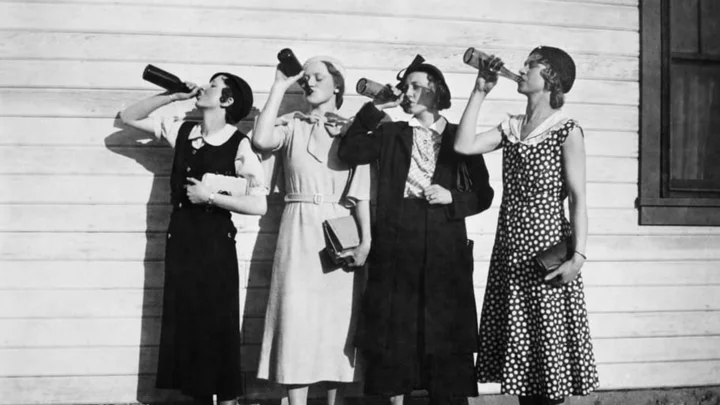It was New Year’s Eve 1919, and revelers across the country savored what they believed would be their last boozy celebration before a new era rushed in. Alcohol production and sales would be banned in the United States on January 17, 1920, under the Volstead Act. Society was standing at the precipice of an age that would change things forever—and not in the way most thought.
Many believed forcing America to go dry would create a society that replaced the vices of alcohol with soda pop and chewing gum, but others saw opportunity knocking. Figures like Al Capone, Lucky Luciano, and Bugs Moran dominated the bootleg scene. It was an exciting and lucrative realm. Reports suggest that by 1930, contraband liquor was a multi-billion dollar industry that attracted more than your run-of-the-mill criminal.
Many believed women bootleggers were few and far between. Mary Sullivan, director of the New York Women’s Police Department, argued in 1926 that women were incapable of such jobs. However, historically speaking, the accounts of successful women in this realm prove her views were more wishful thinking than reality; it’s thought there were five women for every male bootlegger. They were able to hide and transport alcohol under their layered garments, and also took advantage of the fact that male police officers legally couldn’t search them.
With many fascinating stories that have slipped through the cracks of history, it’s impossible to account for all the daring dames who ventured into the underworld of contraband liquor, but there are some whose tales stand the test of time.
1. Gertrude “Cleo” Lythgoe
Nicknamed “Cleo” after the legendary pharaoh Cleopatra, pistol-slinging Gertrude Lythgoe was tall, ever-so-stylish, and smart as a whip. She also smoked like a chimney and loved singing. Lythgoe had many love interests but never desired to settle down. “I’ve stood on my own feet, and I’m ashamed of nothing. I’m my own boss, and I’ll never take a husband to boss me,” she declared.
She initially worked as a stenographer, but soon found a better opportunity working for a whisky wholesaler out of Britain and New York. When The Volstead Act threw a wrench in business, Lythgoe moved to the Bahamas, intending to lead Scotch whisky imports to the island nation before rerouting the liquid gold to America for illegal resale.
She lived at the Lucerne Hotel, a known hotbed for bootleggers, and set her sights on the dangerous, male-dominated industry. She befriended famous rum smuggler Bill McCoy and used his fleet to transport her liquor north from the Bahamas to Rum Row, a stretch of international waters off the U.S. coast where ships filled with contraband liquor bobbed at sea, awaiting small dispatch vessels to arrive and sneak the cargo to mainland America. Lythgoe later built her own sailing fleet and gained a reputation for her reliable business acumen and quality Scotch.
Between 1920 and 1925, she made millions moving liquor into port cities like New York. She was so successful she became an unlikely celebrity, often making front-page news.
Lythgoe was arrested and brought in front of the New Orleans courts shortly after surviving a shipwreck. Although she managed to avoid jail time, she believed she had a jinx on her head and feared for her life. She abruptly quit rum running in 1925 at the height of her success. “I’m out of it for good. I just beat my jinx before it got me. It was terrible to watch it coming,” she told reporters months later. She spent the rest of her life moving between hotels.
2. Mary Louise Cecilia “Texas” Guinan
Mary Louise Cecilia Guinan loved the limelight. She married young, and relocated from Texas to Chicago with her cartoonist husband. But Guinan found that she hated life as a housewife. She wanted to be an entertainer, so, in 1906, she left her husband and ventured to New York City to pursue a career onstage.
Struggling to make ends meet in a city full of hopeful stars, she eventually got into Vaudeville theater as a rowdy gunslinging cowgirl called “Texas” Guinan. Her against-the-grain character and expressive looks got her noticed, and she shot to stardom in the silent movies. But by the time the 1920s roared in, Guinan was in her late thirties and found that ageism was taking a toll on her career.
The vivacious star found new fame as an events host among the Big Apple’s growing anti-Prohibition speakeasies. She was hired by well-known bootlegger Larry Fay—who opened the El Fey nightclub—to hype up the crowd so they’d stay longer and buy more booze. Guinan later decided to fly solo and established several more clubs throughout the city, earning the moniker “Queen of the Nightclubs.” Though the city was crawling with speakeasies and low-brow drinking holes called “blind pigs,” few clubs could compare to the ones she led.
Guinan gained notoriety for engaging the drunken crowd with jokes, taunts, sketch comedy, and sing-alongs. She was also known for greeting patrons with her once-famous tagline, “Hello, Sucker.” Her clubs were frequented by celebrities like Babe Ruth and Charlie Chaplin; rumors have it that she often hosted the abdicated King Edward VIII, who, in one instance, pretended to be kitchen staff during a police raid.
As the era wound down, Guinan attempted to return to her stage-acting roots for a short stint before dying suddenly in 1933 in Vancouver, Canada. Her funeral, held in her beloved New York, saw a turnout of thousands, with people stealing procession flowers and violently fighting for a glimpse of her coffin.
3. Besha “Bessie” Starkman-Perri
Besha “Bessie” Starkman lived a rather ordinary life—at least at first. The seamstress-turned-housewife raised two young daughters in Toronto’s densely populated and notorious slum, St. John’s Ward. Starkman was a bold talker with a knack for numbers and an opportunist mindset. She opened her home to room renters to supplement her husband’s wages as a bakery driver, but wanted more out of life and desired to change her circumstances for good.
When a Calabrian man named Rocco Perri decided to rent with the family, his winning smile and larger-than-life ambitions won her over. The two took off to a neighboring city near the American border to start a life together. From there, they teamed up to create a bootlegging empire that would rival the likes of Al Capone.
Their dealings were initially small. Starkman operated an in-home brothel, Perri provided small batches of illegal liquor to customers, and they both dabbled in racetrack betting. In time, however, business boomed, and they raked in over $1 million a year—more than $13 million today.
Flagged time and again by police in violation of several laws, including Canada’s Temperance Act (the equivalent of America’s Volstead Act), the couple cunningly pushed forward with their criminal activity. While Perri used his charm and diplomacy to network with liquor suppliers and customers on both sides of the border, Starkman positioned herself as the bookkeeper and strategist of their operation; behind closed doors, she was the brains of the gig, and Perri relied on her. In the media and in the courts, however, she played the innocent wife. But her wise-gal days were numbered.
Starkman was ambushed with a shotgun while returning home one August night in 1930. There was nearly $10,000 worth of jewelry left on her body, so robbery as a motive was out of the question. On the day of her funeral in Hamilton, Ontario, thousands of mourners came out to bid farewell to one of Prohibition’s more prolific female bootleggers. Her murder remains a mystery to this day.
4. “Moonshine Mary” Wazeniak
Some amateur moonshiners, desperate to keep their income flowing and customers happy, turned to a quick yet dangerous solution: methanol. They repurified the widely available, highly toxic wood alcohol to make it less lethal and mask the terrible flavor with sugar and colorant. The poison hooch passed as everything from whisky to rum. But if distilled improperly, it could cause nerve damage, blindness, or death.
The latter was the case for George Rheautan, who went for a drink with coworkers one November night in 1923. Having purchased a few shots for 15 cents each, Rheautan dropped dead near the blind pig where he’d spent the evening. It wasn’t long before Mary Wazeniak, owner of the saloon, was in hot water.
“Moonshine Mary,” as the media labeled her, was described as a Polish working-class mother who ran a popular watering hole out of her Brookfield, Illinois, home. In her testimony, she claimed her business was solely to support her terminally ill husband and three children. The law didn’t care.
To deter others from pursuing similar ventures, she was made an example of and was handed one year to life for manslaughter. It was the first moonshine sale conviction in Illinois history. Wazeniak wept as she was shackled and led to the notorious Joliet prison. What happened to her after that is unknown.
5. “Spanish Marie” Waite
Marie Waite and her husband, Charlie, were a power couple in the rum-running industry, operating a fleet of fast boats that carried liquor between Havana, Miami, and the Florida Keys. They lived lavishly, owned several properties, and rubbed shoulders with many wealthy clients eager to buy quality Cuban rum.
But their high life together was short-lived. In April 1927, Charlie ran into trouble with the U.S. Coast Guard, which caught him and several accomplices unloading 300 cases of contraband liquor from a boat. Charlie was fatally shot in the ensuing gun battle.
Despite her loss, Waite wasn’t willing to sit back and let someone else take the reins of her rum empire. Her determination never failed—plus, she had two kids to feed. She continued her lucrative hustle between Cuba and Florida, managing up to 15 schooners and a nimble crew. Whenever the Coast Guard was in pursuit, Waite was quick to find new ways to outsmart them.
Her crew used an offshore radio to listen for live updates about Coast Guard activities and trade instructions in Spanish to dodge them. “Spanish Marie,” as she had become known, was an unshakable powerhouse.
Despite being caught several times for smuggling large quantities of rum, Waite always managed to get off with a slap on the wrist or a fine. Most notable was the blunder of 1928, when Kid Boots, her flagship, was apprehended with more than 500 casks of rum onboard.
Though legend boasts that Waite skipped trial and vanished—boat, fortune, and all—that's far from the truth. She paid her $3000 fine and continued rum-running for many more years, which included several new run-ins with the law, new husbands, new names, and plenty of hijinks. After prohibition ended, Waite, always a trailblazer, became Florida’s first woman auto mechanic. As she put it, “Women are capable of doing any man’s job.”
6. Mary Dowling
Upon her husband’s death, Mary Dowling took the helm of one of America’s largest and iconic bourbon manufacturers, the Waterfill and Frazier Distilling Company. It was a position unheard of for women, but she was up for the challenge. Dowling successfully ran the distillery for decades—until Prohibition threw her a wrench.
Dowling knew she had to act quickly to protect her life’s work and sought to find a loophole. Though many believe the 18th Amendment banned all alcohol, medicinal alcohol was permitted. Not surprisingly, alcohol prescriptions to treat everything from asthma to diabetes skyrocketed across America. Dowling’s application for a medical whiskey brewing license was denied, leaving her no choice but to close her distilleries.
But she wasn’t about to toss away the 3500 gallons of premium bourbon in her warehouse. Instead, she sold off as much as possible to bootleggers, shady doctors, and numerous under-the-table clients. She stored what remained under the floorboards and in the basement of her house, where her stash remained until a pair of bootleggers-turned-informants managed to entrap Dowling into selling bourbon to them. Dry agents accused Dowling and her grown children of breaking Prohibition laws. They turned her house upside and confiscated nearly 500 cases of whiskey, totaling $50,000.
For several years, Dowling relentlessly claimed her family broke no laws because the booze was for personal consumption and not for sale. She pushed to have the charges dropped and demanded her whiskey be returned. But it was no use. The family was found guilty; Dowling and her daughters were heavily fined, and her two sons received one-year prison sentences.
Despite all this, Dowling continued trying to keep her business alive and outsmart the law. She moved her entire distillery piece by piece to Juarez, Mexico, with the help of Joe and Harry Beam (of the Beam whiskey empire) to dodge American Prohibition laws. Dowling and her sons rebranded as Dowling Mexican Distillery and continued to produce whiskey south of the border.
The Dowlings successfully expanded their sales to encompass Central and South America and continued to profit from tourists and bootleggers crossing the Rio Grande from the U.S. Their bourbon was so popular that many legal medicinal distillers struggled to compete. Though Dowling died in 1930—before Prohibition ended—her children maintained the family business and eventually returned production to the U.S.
7. Elise Olmstead
Born in England, Elise Caroline Parché (or Campbell in some instances) served for the British Intelligence during World War I before settling in Canada in 1919. She eventually moved to Seattle, Washington, where she opened a beauty parlor under the moniker Vivien Potter.
Her love of adventure led her to join the Bureau of Investigation as a dry-agent spy. She was tasked with collecting info on former police officer-turned-rum runner Roy Olmstead, who was suspected of leading a sophisticated rum-running ring that saw hundreds of cases of liquor travel between Canada and the U.S. Elise worked undercover as a bookkeeper for Olmstead. As time passed, the unexpected happened: Elise and Roy fell in love and got married. When the dry agents finally asked Elise for intel on Roy, she famously replied, “I cannot testify against him; I am his wife.”
The two moved to a house in Mount Baker and enjoyed all the riches of Roy’s rum-running success. Roy hired local inventor Alfred Hubbard to create the broadest-reaching radio station in the region, which they operated out of their spare bedroom. Elise filled the airwaves as the melodious “Aunt Vivien” who read bedtime stories to children every evening.
But something was strange. Many of the stories were peppered with unusual comments that made little sense to the plot, like the phrase, big bear, run for cover. Prohibition agents, suspecting Elise was transmitting codes to a sophisticated fleet of rum runners, enlisted Hubbard as an informant and began monitoring the station via wiretap.
When federal agents raided the Olmsteads’ home not three months later, Elise was on air telling the tale of Peter Rabbit. Listeners at the time likely heard quite a skirmish followed by the show abruptly going silent. Roy was charged with orchestrating the largest liquor smuggling scheme of that time and served four years in prison. Elise, on the other hand, was miraculously acquitted.
8. Gloria De Caseras
Madame Gloria De Caseras, known as the “beautiful bootlegger,” captivated people on both sides of the Atlantic. De Caseras is said to have been the commander of a fleet of whisky ships that regularly crossed between Britain, Halifax, and Rum Row.
Gloria was married but separated from the son of an Argentine merchant tycoon, and she came from uncertain beginnings. Some speculate she was born Mabel Davy of East London, the daughter of an accomplished sea captain. Others claimed she was a British film star named Gloria De Veres, whose wealthy father helped fund the Russian Bolshevik uprising before mysteriously dying in Japan. Wherever the truth lay, Gloria made headlines wherever she went.
On a return trip from Europe to North America, her five-masted schooner, General Serrett, ran into mechanical trouble. She docked in England unannounced, and it wasn’t long before British authorities came to inspect. They found 10,000 cases of Scotch whisky, presumably bound for America. When asked who owned this booze-laden ship, the captain and crew pointed fingers at De Caseras, head of the Gloria Steamship Company. De Caseras furiously claimed it was a setup. Though the ship might be hers, she swore the booze was not.
De Caseras once again made the headlines while stranded in London as she tried to mitigate her whisky fiasco and a disgruntled crew—this time for stealing a dress from Selfridges, a high-end department store. Although it was determined to be an innocent misunderstanding over an inactive customer credit account, the newspapers had a heyday with it.
De Caseras sold her ship to pay her dues and didn’t appear in the UK again until 1927. She claimed she wanted to return to her homeland for good, and was surprised to find she owed further unpaid fees from her previous debacle. De Caseras had revoked her British citizenship upon marrying her former Argentine husband and was forbidden the right to stay.
With her belongings seized, except for £5 worth of clothing, De Caseras was placed on close surveillance in an upscale hotel room until her deportation. She sailed to Halifax, but unfortunately, Canada didn’t want her either. She was too much of a liability. As the so-called “Queen without a home” declared, "I am a woman apparently without a country, although I was born in England."
De Caseras was greeted with a similar attitude when she later arrived in New York, which she was told she had 15 days to leave. She made her way inland and vanished. News of her plans to marry Albert Charboneau, an American business partner with rum-running investments, appeared in the paper a while later.
This article was originally published on www.mentalfloss.com as Queens of Prohibition: The Wild Story of 8 Women Bootleggers, Moonshiners, and Rum Runners.









